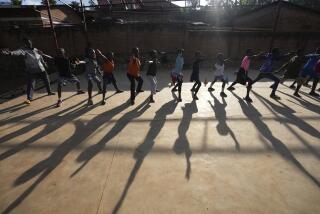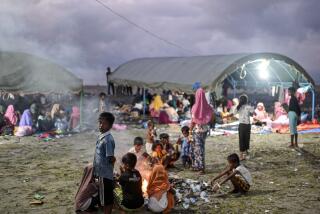For Rwandan Refugees on Run, Home Beckons
- Share via
KASISI, Zaire — After six months and nearly 600 miles, a long-missing group of Rwandan Hutu refugees has reached the end of the road in a sad, strange odyssey.
Here in Zaire’s jungle gloom, where towering trees and thick foliage block the equatorial sun, most of the refugees--who fled deeper into Zaire last year instead of returning home with hundreds of thousands of their brethren--say they have been on the run long enough.
Now they want to go home.
“In the name of all refugees, we want to go back to Rwanda,” Jean Ntawukirasongwa, a self-appointed spokesman, pleaded Saturday as a crowd of haggard refugees shouted agreement. “We want to go back, even if by foot. All we want is security. We don’t want to be attacked.”
The Rwandans, perhaps 70,000 in all, are scattered in four pitiful groups along 50 miles on the west bank of the giant Zaire River. Their ragged plastic tents, rain-soaked blankets and smoky cooking fires hug a winding dirt track and narrow-gauge railway line carved out of the dense rain forest and oozing swamps. Most are barefoot and in rags.
“We have no food, no clothes, no shoes,” Anatoli Sekamanu, 46, said as he lay on a mat in the mud with his feverish wife and four gaunt children. “When it rains, we suffer so much. We have much sickness. We just want to go home.”
From the start of their trek, this breakaway group of refugees was led by tens of thousands of exiled Hutu soldiers and militiamen. Many were fleeing because they feared reprisals for their role in the orchestrated genocide of Tutsis, Rwanda’s ethnic minority, and moderate Hutus in that country’s 1994 civil war.
It has never been clear whether the refugees were active supporters of the mass murderers among them or were their hostages. Either way, the Rwandan soldiers dug trenches and machine-gun nests in makeshift camps and scattered antipersonnel mines nearby. The refugees thus became targets of repeated attacks by Zairian rebels whom they began fleeing in September.
“When we were running away, we always hope to go back,” said refugee Aristarque Muhayimana, 31, whose son Ovide was born two weeks ago. “The problem was how to go back. They [the rebels] keep on attacking us.”
Now they have reached the end of the road: a bamboo pole, guarded by three rebel soldiers, outside the village of Lula. The insurgents, who control all of eastern Zaire, have refused to let the estimated 20,000 refugees massed at Lula enter the newly captured city of Kisangani, just north and across the Zaire River.
Saying they fear that the refugees will cause instability or spread disease, rebel leaders also have refused to allow the U.N. to fly the sick and wounded out of Kisangani. That has created a nightmare for aid workers eager to treat and repatriate the refugees as quickly as possible.
Aid workers say most of the refugees appear relatively healthy, if understandably weary. But many, especially women and children, suffer from open wounds, malaria, malnutrition, dehydration, diarrhea and other problems from months of foraging in the forest.
The worst off are the stragglers, farthest south on the road.
“We saw skeleton types, zombies coming from the jungle,” said Kilian Kleinschmidt, a field officer for the Office of the U.N. High Commissioner for Refugees who helped distribute 120 tons of food that arrived by train last week. He said he counted 20 bodies and scores of others who appeared near death.
“They’re sitting in the forest, waiting to die,” he said. “How many, we don’t know.”
The refugees were among those who abandoned a squalid string of U.N. camps at Zaire’s border with Rwanda starting in September. They fled after the Zairian insurgents, backed by Rwanda’s government, began shelling or threatening the camps in a conflict aimed at toppling Zaire’s dictator, Mobutu Sese Seko.
About 700,000 refugees from the camps suddenly returned to Rwanda in November, pouring en masse across the border from Zaire and back to their villages.
Tens of thousands more--1,400 near the border city of Goma in a recent week alone--have streamed home since then, often after months of wandering in some of the world’s thickest jungles and a brutal volcanic nether world known as Mountains of the Moon.
The group here makes up the core of those who fled deeper into Zaire. Estimates of how many began the grueling trek vary widely. The U.N. refugee agency originally claimed that about 350,000 refugees were missing, but the U.S. government and others insisted that the actual figure was far lower.
Whatever their number, the refugees hiked steadily northwest over the months, building and then abandoning makeshift camps at Sake, Walikale, Amisi, Tingi-Tingi and Ubundu. Despite aid deliveries, thousands are believed to have died of hunger, disease and exhaustion along the way.
The refugees here split from the main body of hard-line Hutu soldiers about eight days ago after the soldiers fought another battle with the Zairian rebels. Several thousand Rwandan troops and their families pushed farther west, although some dropped their military identification cards and uniforms so they could join the refugees as civilians.
But now the refugees have come to a halt.
“They’re hanging by a logistical thread at this point,” said Paul Stromberg, a UNHCR spokesman in Kisangani. “They’re so far from Goma that we’re talking trains, planes, trucks, boats and feet to get them home.”
The United Nations plans to airlift up to 50 large trucks to Kisangani, starting Tuesday, to help the refugees make their way home. If the rebels approve, the U.N. refugee agency plans to build transit stations and clinics along the way to provide food, medical care and other assistance.
“It’s the last big group,” Stromberg said. “We want to help them go home.”
More to Read
Sign up for Essential California
The most important California stories and recommendations in your inbox every morning.
You may occasionally receive promotional content from the Los Angeles Times.











